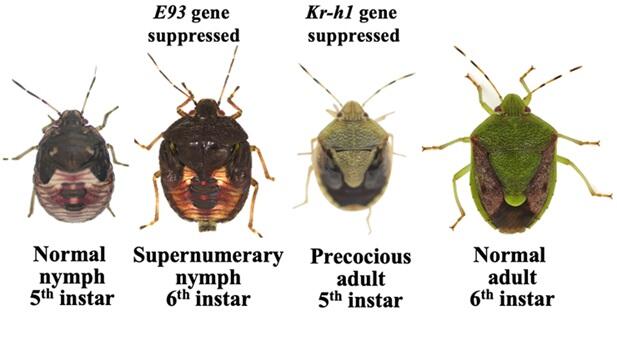A research group led by Senior Researcher Minoru Moriyama of the Symbiotic Evolution and Biological Functions Research Group in the Bioproduction Research Institute (BPRI) at the National Institute of Advanced Industrial Science and Technology (AIST) and Graduate Student Sayumi Oishi of the Graduate School of Science at the University of Tokyo (former Technical Trainee of AIST) announced their discovery that during metamorphosis, the stinkbug species Plautia stali changes its morphology and function of organs that retain intestinal symbiotic bacteria. Using Plautia stali, they successfully manipulated the genes that control insect morphology. They further found that metamorphosis controls not only the morphology of the insect itself, but also the function of the intestinal symbiotic bacteria. Their findings are expected to lead to the development of pest control methods that target metamorphosis and symbiotic functions. The results were published in the September 28, 2023 issue of PNAS.

Provided by AIST
There are more than 40,000 species of stinkbugs around the world, with more than 1,500 species in Japan; several agricultural pests are classified as stinkbugs. In general, the expression of metamorphosis-controlling genes in insects changes according to the activity of the juvenile hormones that trigger ecdysis (the process of shedding the outer cuticle), leading to metamorphosis from larva to adult. However, the association between insect metamorphosis and symbiotic relationships with microorganisms is not well understood.
A previous study indicated that Plautia stali has multiple sac-like structures (caeca) along the rear end of its gastrointestinal tract that hold intestinal symbiotic bacteria, and these structures are markedly different in larvae and adults. Furthermore, the front end of the symbiotic organ in larvae is completely closed and does not allow food to enter, whereas that in the adults is open and allows food inflow.
In this study, the research group discovered that in Plautia stali, the form and function of these symbiotic organs at the rear end of the digestive tract change upon metamorphosis of the larva into an adult, and the switch is regulated by the genes that control metamorphosis. Moreover, they revealed that the larval symbiotic organs are specialized to merely retain intestinal symbiotic bacteria, whereas the adult symbiotic organs are responsible for food digestion and absorption as well.
Additionally, if the expression of the larval genes is suppressed, both the appearance and symbiotic body organs of the organism will become adult type. Thus, the role of adult symbiotic organs that allowed food inflow in the digestive function was verified.
Upon examining the gene expression patterns of the intestinal symbiotic bacteria, the researchers found that the genes involved in the synthesis of amino acids (cysteine, etc.) were expressed at significantly higher levels across all adult symbiotic organs than that in the larvae. The cysteine content in the body fluid of adults was significantly higher than that of larvae. Moreover, the cysteine content in the amount in the eggs was higher than that in the peanuts they feed on or in the entire adult body, and most of this amino acid was localized in the eggshell. Cysteine enhances the structure of proteins by forming disulfide cross-links in the molecules, which are considered important for the hardness and durability of eggshells.
Female Plautia stali adults have robust fecundity (healthy fertility) and are capable of laying approximately 14 eggs every 2-3 days for more than one month, if given enough food. The researchers speculate that this reproductive ability is sustained by the high cysteine content produced by the intestinal symbiotic bacteria in the adults.
Moriyama commented, "This research was actively carried out by Ms. Oishi (currently a researcher at Otsuka Pharmaceutical), who was a graduate student at the University of Tokyo. She noticed that the morphology of the symbiotic organs in Plautia stali was very different in larvae and adults, and she steadily accumulated data over several years to clarify its significance, while learning various experimental techniques. I must give credit to her insatiable spirit of inquiry and daily study that led her to the discovery of this important biological phenomenon."
Journal Information
Publication: PNAS
Title: Regulation and remodeling of microbial symbiosis in insect metamorphosis
DOI: 10.1073/pnas.2304879120
This article has been translated by JST with permission from The Science News Ltd. (https://sci-news.co.jp/). Unauthorized reproduction of the article and photographs is prohibited.




